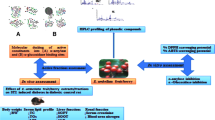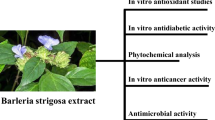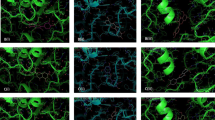Abstract
In this study, antioxidative methanolic leaf extract (MeOH-SIS) of Urtica dioica was characterized for anti-diabetic activity. The extract was purified on a column to yield seven homogenous fractions (F1–F7) which were further determined for DPPH radical scavenging activity. MeOH-SIS and the fraction F1 (selected based on % yield and activity) were evaluated for their in vitro α-amylase and α-glucosidase inhibitory activity. The results showed inhibition of both enzymes in a dose dependent manner and F1 exhibited relatively higher inhibition than its mother extract MeOH-SIS. GC–MS analyses of both the extracts identified 24 major compounds among which 10 were previously described as bioactive compounds. Among all, 5 compounds demonstrated to have quality pharmacokinetics profiles and were examined for possible binding affinity against the active sites of α-amylase and α-glucosidase using molecular docking. The binding interaction of 2R-acetoxymethyl-1,3,3-trimethyl-4 T-(3-methyl-2-buten-1-yl)-1 T-cyclohexanol within the active sites of the target receptors was found to be significant among others, and can be developed as a potential inhibitor of α-amylase and α-glucosidase. The leaf extract can be utilized to develop food additive for the control and management of oxidative stress induced diabetes.



Similar content being viewed by others
Data availability
All datasets generated for this study are included in the article/supplementary material.
Code availability
Not applicable.
References
Ahmed M, Peiwen Q, Gu Z, Liu Y, Sikandar A, Hussain D et al (2020) Insecticidal activity and biochemical composition of Citrullus colocynthis, Cannabis indica and Artemisia argyi extracts against cabbage aphid (Brevicoryne brassicae L.). Sci Reports 10(1):1–10
Anupama N, Madhumitha G, Rajesh KS (2014) Role of dried fruits of Carissa carandas as anti-inflammatory agents and the analysis of phytochemical constituents by GC–MS. Biomed Res Int 2014:512369
Babatunde DE, Otusemade GO, Efeovbokhan VE, Ojewumi ME, Bolade OP, Owoeye TF (2019) Chemical composition of steam and solvent crude oil extracts from Azadirachta indica leaves. Chem Data Collect 20:100208
Bhat RS, Al-Daihan S (2014) Phytochemical constituents and antibacterial activity of some green leafy vegetables. Asian Pac J Trop Biomed 4(3):189–193
Black HS, Boehm F, Edge R, Truscott TG (2020) The benefits and risks of certain dietary carotenoids that exhibit both anti-and pro-oxidative mechanisms—a comprehensive review. Antioxidants 9(3):264
Boeing JS, Barizão ÉO, e Silva BC, Montanher PF, de Cinque AV, Visentainer JV (2014) Evaluation of solvent effect on the extraction of phenolic compounds and antioxidant capacities from the berries: application of principal component analysis. Chem Cent J 8(1):1–9
Boelsterli UA, Kashimshetty R (2010) Idiosyncratic drug-induced liver injury: mechanisms and susceptibility factors. In: McQueen CA (ed) Comprehensive toxicology, 2nd edn. Elsevier, Netherlands, pp 383–402
Brouwer-Brolsma EM, Brandl B, Buso MEC, Skurk T, Manach C (2020) Food intake biomarkers for green leafy vegetables, bulb vegetables, and stem vegetables: a review. Genes Nutr 15(1):1–12
Chourasia R, Kumari R, Singh SP, Sahoo D, Rai AK (2022) Characterization of native lactic acid bacteria from traditionally fermented chhurpi of Sikkim Himalayan region for the production of chhurpi cheese with enhanced antioxidant effect. LWT Food Sci Technol 154:112801
Chrubasik JE, Roufogalis BD, Wagner H, Chrubasik S (2007) A comprehensive review on the stinging nettle effect and efficacy profiles. Part II: urticae radix. Phytomedicine 14(7–8):568–579
Falowo AB, Muchenje V, Hugo A, Aiyegoro OA, Fayemi PO (2017) Antioxidant activities of Moringa oleifera L. and Bidens pilosa L. leaf extracts and their effects on oxidative stability of ground raw beef during refrigeration storage. CYTA J Food. 15 (2):249-256
Hall J, Bravo-Clouzet R (2013) Anti-Inflammatory Herbs for Arthritis. In: Watson RR, Preedy VR (eds) Bioact food as dietary intervention arthritis and related inflammatory diseases. Academic Press, Cambridge, pp 619–631
Ibrahim MA, Bester MJ, Neitz AW, Gaspar ARM (2018) Rational in silico design of novel α-glucosidase inhibitory peptides and in vitro evaluation of promising candidates. Biomed Pharmacother 107:234–242
Ibrahim MA, Koorbanally NA, Islam MS (2014) Antioxidative activity and inhibition of key enzymes linked to type-2 diabetes (α-Glucosidase and α-Amylase) by khaya senegalensis. Acta Pharm 64(3):311–324
Ibrahim RYM, Hammad HBI, Gaafar AA, Saber AA (2022) The possible role of the seaweed Sargassum vulgare as a promising functional food ingredient minimizing aspartame-associated toxicity in rats. Int J Environ Health Res 32:752–771
Islam MT, Ali ES, Uddin SJ, Shaw S, Islam MA, Ahmed MI et al (2018) Phytol: a review of biomedical activities. Food Chem Toxicol 121:82–94
Joshi RK (2018) Volatile Constituents of Emilia sonchifolia from India. Nat Prod Commun. 13(10):1355–1356
Kalai FZ, Dakhlaoui S, Hammami M, Mkadmini K, Ksouri R, Isoda H (2022) Phenolic compounds and biological activities of different organs from aerial part of Nitraria retusa (Forssk.) Asch.: effects of solvents. Int J Food Prop 25:1524–1538
Kalayoglu M, Singer M (2013) U.S. Patent No. US20130178525A1. Washington, DC: U.S. Patent and Trademark Office
Khalid W, Iqra AF, Rahim MA, Rehman AA, Rasul HF, Arshad MS, Ambreen S, Zubair M, Safdar S, Al-Farga A, Refai M (2023) Industrial applications of kale (Brassica oleracea var. sabellica) as a functional ingredient: a review. Int J Food Prop. 26(1):489–501
Khajuria V, Gupta S, Sharma N, Kumar A, Lone NA, Khullar M, Dutt P, Sharma PR, Bhagat A, Ahmed Z (2017) Anti-inflammatory potential of hentriacontane in LPS stimulated RAW 264.7 cells and mice model. Biomed Pharmacother. 92:175-186
Kianbakht S, Khalighi-Sigaroodi F, Dabaghian FH (2013) Improved glycemic control in patients with advanced type 2 diabetes mellitus taking Urtica dioica leaf extract: a randomized double-blind placebo-controlled clinical trial. Clin Lab 59(9–10):1071–1076
Lipinski CA (2008) ADMET screen. encycl cancer 74–77. In: Schwab M (ed) Encyclopedia of cancer. Springer, Heidelberg, pp 74–77
Liu Y, Grimm M, Dai W-t, Hou M-c, Xiao ZX, Cao Y (2020) CB-Dock: a web server for cavity detection-guided protein–ligand blind docking. Acta Pharmacol Sin 41(1):138–144
Malheiro R, Casal S, Cunha SC, Baptista P, Pereira JA (2016) Identification of leaf volatiles from olive (Olea europaea) and their possible role in the ovipositional preferences of olive fly, Bactrocera oleae (Rossi) (Diptera: Tephritidae). Phytochemistry 121:11–19
Manjari MS, Karthi S, Ramkumar G, Muthusamy R, Natarajan D, Shivakumar MS (2014) Chemical composition and larvicidal activity of plant extracts from Clausena dentata (Willd) (Rutaceae) against dengue, malaria, and filariasis vectors. Parasitol Res 113(7):2475–2481
Meunier L, Larrey D (2019) Drug-induced liver injury: biomarkers, requirements, candidates, and validation. Front Pharmacol 10:1482
Naine SJ, Devi CS, Mohanasrinivasan V, Doss CGP, Kumar DT (2016) Binding and molecular dynamic studies of sesquiterpenes (2R-acetoxymethyl-1,3,3-trimethyl-4t-(3-methyl-2-buten-1-yl)-1t-cyclohexanol) derived from marine Streptomyces sp. VITJS8 as potential anticancer agent. Appl Microbiol Biotechnol 100(6):2869–2882
Padhi S, Masi M, Chourasia R, Rajashekar Y, Rai AK, Evidente A (2021) ADMET profile and virtual screening of plant and microbial natural metabolites as SARS-CoV-2 S1 glycoprotein receptor binding domain and main protease inhibitors. Eur J Pharmacol 890:173648
Pieczykolan A, Pietrzak W, Gawlik-Dziki U, Nowak R (2021) Antioxidant, anti-inflammatory, and anti-diabetic activity of phenolic acids fractions obtained from Aerva lanata (L.) Juss. Mol 26(12):3486
Poovitha S, Parani M (2016) In vitro and in vivo α-amylase and α-glucosidase inhibiting activities of the protein extracts from two varieties of bitter gourd (Momordica charantia L.). BMC Complement Altern Med 16(1):1–8
Pratama OA, Tunjung WAS, Sutikno DBS (2019) Bioactive compound profile of melon leaf extract (Cucumis melo L. ‘Hikapel’) infected by downy mildew. Biodiversitas J Biol Divers 20(11):3448–3453
Rahman A, Hoque MM, Khan MA, Sarwar MG, Halim MA (2016) Non-covalentinteractions involving halogenated derivatives of capecitabine and thymidylatesynthase: a computational approach. Springerplus 5:146
Ralte L, Khiangte L, Thangjam NM, Kumar A, Singh YT (2022) GC–MS and molecular docking analyses of phytochemicals from the underutilized plant, Parkia timoriana revealed candidate anti-cancerous and anti-inflammatory agents. Sci Reports 12(1):1–21
Ramya R (2022) GC–MS Analysis of bioactive compounds in ethanolic Leaf extract of Hellenia speciosa (J.Koenig) S.R Dutta. Appl Biochem Biotechnol 194:176–186
Sekhon-Loodu S, Rupasinghe HPV (2019) Evaluation of antioxidant, antidiabetic and antiobesity potential of selected traditional medicinal plants. Front Nutr 6:53
Sharma S, Padhi S, Kumari M, Patnaik S, Sahoo D (2022) Antioxidant potential of selected wild edible leafy vegetables of Sikkim Himalayan region: effects of cooking methods and gastrointestinal digestion on activity. Front Nutr 9:598
Siswadi S, Saragih GS (2021) Phytochemical analysis of bioactive compounds in ethanolic extract of Sterculia quadrifida R.Br. AIP Conf Proc 2353(1):030098
Sunarić S, Lalić J, Spasić A (2017) Simultaneous determination of alpha-tocopherol and alpha-tocopheryl acetate in dairy products, plant milks and health supplements by using spe and hplc method. Food Anal Methods 10(12):3886–3901
Talukdar R, Padhi S, Rai AK, Masi M, Evidente A, Jha DK et al (2021) Isolation and characterization of an endophytic fungus Colletotrichum coccodes producing tyrosol from Houttuynia cordata Thunb. Using ITS2 RNA secondary structure and molecular docking study. Front Bioeng Biotechnol 9:484
Thimmegowda SC, Naidoo YNJR, Naidoo G (2013) Chemical composition of the essential oil from the leaves of Endostemon obtusifolius (E.Mey. ex Benth.) N.E.Br. BiochemPharmacol 2:4
Van Breemen RB, Li Y (2005) Caco-2 cell permeability assays to measure drug absorption. Expert Opin Drug Metab Toxicol 1(2):175–185
Witchel HJ, Harry Witchel CJ (2011) Drug-induced hERG Block and Long QT Syndrome. Cardiovasc Ther 29(4):251–259
Xiong G, Wu Z, Yi J, Fu L, Yang Z, Hsieh C et al (2021) ADMETlab 2.0: an integrated online platform for accurate and comprehensive predictions of ADMET properties. Nucleic Acids Res 4(W1):W5–W14
Zhang JW, Feng YX, Du YS, Lu XX, Zheng Y, Wang D et al (2022) Composition and insecticidal activity of Elsholtzia kachinensis Prain, a traditional vegetable and herbal medicine. J Oleo Sci 71(7):1075–1084
Acknowledgements
We acknowledge Institute of Bioresource and Sustainable Development and Department of Biotechnology, Ministry of Science and Technology, Govt. of India for the funding for conducting the research work.
Funding
The research work was supported by Department of Biotechnology, Govt. of India.
Author information
Authors and Affiliations
Contributions
SS-Conducted the experiments, performed the data analyses and Writing-original draft; SP-performed the data analyses, Writing—original draft, review & editing; RC-performed the data analyses, Writing—original draft; SD-performed the data analyses; SP-Conceptualization, and Writing—review & editing. DS-Conceptualization, Project administration, review & editing. The final manuscript was read and approved by all contributors.
Corresponding author
Ethics declarations
Conflict of interest
The authors declare no competing interests.
Ethical approval
Not applicable.
Consent to participate
Not applicable.
Consent for publication
Not applicable.
Additional information
Publisher's Note
Springer Nature remains neutral with regard to jurisdictional claims in published maps and institutional affiliations.
Rights and permissions
Springer Nature or its licensor (e.g. a society or other partner) holds exclusive rights to this article under a publishing agreement with the author(s) or other rightsholder(s); author self-archiving of the accepted manuscript version of this article is solely governed by the terms of such publishing agreement and applicable law.
About this article
Cite this article
Sharma, S., Padhi, S., Chourasia, R. et al. Phytoconstituents from Urtica dioica (stinging nettle) of Sikkim Himalaya and their molecular docking interactions revealed their nutraceutical potential as α-amylase and α-glucosidase inhibitors. J Food Sci Technol 60, 2649–2658 (2023). https://doi.org/10.1007/s13197-023-05789-x
Revised:
Accepted:
Published:
Issue Date:
DOI: https://doi.org/10.1007/s13197-023-05789-x




